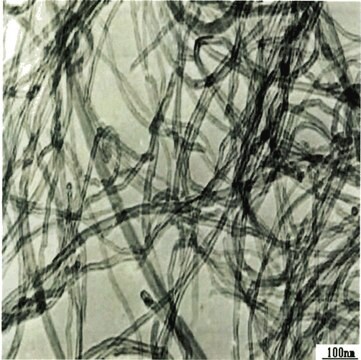755133
Carbon nanotube, multi-walled
thin, <5% Metal Oxide(TGA)
Synonym(s):
NC-3100, MWCNT, MWNT, Multiwall carbon nanotube
About This Item
Recommended Products
form
powder
avg. diam. × L
9.5 nm × 1.5 μm , TEM
impurities
<5% Metal Oxide (TGA)
mp
3652-3697 °C (lit.)
density
~2.1 g/mL at 25 °C (lit.)
Looking for similar products? Visit Product Comparison Guide
General description
Application
Electronics
Sensors
Composites
Energy Storage
Study of Life Science system
Preparation Note
Legal Information
Storage Class Code
11 - Combustible Solids
WGK
WGK 3
Flash Point(F)
Not applicable
Flash Point(C)
Not applicable
Choose from one of the most recent versions:
Already Own This Product?
Find documentation for the products that you have recently purchased in the Document Library.
Customers Also Viewed
Articles
3D printing is a type of additive manufacturing that can be used to rapidly fabricate components with highly customizable geometries.
Boron nitride nanotubes (BNNT) are close structural analogs of carbon nanotubes (CNT), which are high aspect ratio nanotubular material, where carbon atoms are alternately substituted by nitrogen and boron atoms.
Carbon nanotubes (CNTs) have received much attention since their discovery in 1991 by Sumio lijima1 due to their excellent mechanical, electrical, and optical properties.
A nanocomposite is typically defined as a mixture between a host material (e.g., polymer matrix) and nanofillers with at least one dimension of less than 100 nm.
Our team of scientists has experience in all areas of research including Life Science, Material Science, Chemical Synthesis, Chromatography, Analytical and many others.
Contact Technical Service





